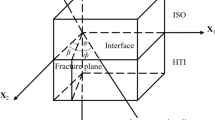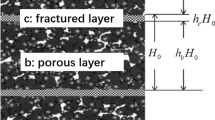Abstract
Marlstone reservoirs are closely related to the degree of fracture development and their hydrocarbon accumulation are also controlled by the distribution of fractures. Hence, the prediction of fracture development zones is very important to the discovery of fractured oil and gas reservoirs. Tectonic movements and their intensities are one of the key factors affecting the formation of fracture systems and the distribution of tectonic stress field has great impact on the generation of fractures. Therefore, taking marginal subsags in the Jiyang Depression, Eastern China, as an example, this paper studied the characteristics of seismic wave propagation in fractured marlstone reservoirs based on mechanical principles. This study proposed the equivalent geological model and elastic characterization parameters for the fractured marlstone reservoirs in study area, analyzed the seismic response patterns, anisotropy characteristics, and seismic wave-field distribution of the marginal subsags in the Jiyang Depression, discussed the influences of fracture filling fluid, density, inclination, orientation, and layer thickness on the characteristics of seismic wave propagation in fractured marlstone reservoirs, and finally explored the shear wave splitting phenomenon and the exploration and development significance of the seismic wave propagation in fractured marlstone reservoirs. The study results show that the fracture filling fluid can lead to the dispersion and attenuation of seismic wave propagating in the medium, and rock saturated with fluid can exhibit frequency-dependent attenuation and dispersion due to wave-induced fluid flow between pores and fractures. The change of fracture density can make seismic wave appear anisotropic and biphasic and the difference between the high and low frequency of the longitudinal wave phase velocity becomes more and more obvious. The change of fracture inclination and orientation can cause the shear wave splitting phenomenon, in which the fast shear wave polarized parallel to the fracture with a fast velocity and a slow attenuation and the slow shear wave is polarized in the direction perpendicular to the crack with slow velocity and fast attenuation. The change of fracture layer thickness can make because the change of phase velocity and attenuation and the larger the thickness of the fracture layer is, the greater the difference between the reflection amplitude of the bottom interface and that of the non-fracture layer is. The study of characteristics of seismic wave propagation in fractured marlstone reservoirs can effectively obtain the multi-directional shear wave impedance and then fine characterize the fracture strike and density of tight oil fractured reservoir, which has important theoretical research and practical exploration significance. The study results provide a reference for further researches on the characteristics of seismic wave propagation in fractured marlstone reservoirs based on mechanical principles.








Similar content being viewed by others
References
Ali M, Gholipour, John W, Cosgrove ML (2016) New theoretical model for predicting and modelling fractures in folded fractured reservoirs. Pet Geosci 22(3):257–280
Allen MB, Macdonald DIM, Xun Z, Vincent SJ, Brouet-Menzies C (1997) Early Cenozoic two-phase extension and late Cenozoic thermal subsidence and inversion of the Bohai basin, northern China. Mar Pet Geol 14(7):951–972
Bakhshi E, Torab FM (2016) Determining wettability of fractured carbonate reservoirs. Nat Resour Res 25(2):211–225
Bing L, Rui Z, Qiangfu K, Shang D, Huili L, Weili Y, Zhongpei Z (2019) An Ordovician carbonate reservoir in strike-slip structures producing from fault-associated fracture systems, 3D seismic region of Northern Shun 8 block (Tarim Basin). Carbonates Evaporites 34(3):545–556
Bouchaala F, Ali MY, Matsushima J, Bouzidi Y, Sultan A (2019) Azimuthal investigation of compressional seismic wave attenuation in fractured reservoir. Geophysics 84(6):1–37
Chen SQ, Zeng LB, Huang P, Sun SH, Zhang WL, Li XY (2016) The application study on the multi-scales integrated prediction method to fractured reservoir description. Appl Geophys 13(1):80–92
Deng S, Yuan X, Wang Y, Liang S, Zhang J (2019) Numerical and experimental simulations of multi-array azimuthal laterolog sonde responses in fractured reservoirs. Geophysics 85(1):1–77
Gao D, Duan T (2017) Seismic structure and texture analyses for fractured reservoir characterization: An integrated workflow. Interpretation 5(4):1–57
Inozemtsev A, Dekel G, Koren Z, Galkin A (2019) Applying full-azimuth depth processing in the Local Angle Domain for Frequency Absorption versus Azimuth (FAVAz) analysis to predict permeable, oil-saturated fractures. First Break 37(1):67–73
Kharazova YV, Pavlenko OV, Dudinskii KA (2016) The correlation between the characteristics of seismic wave propagation in Western Caucasus and the geological-tectonic features of the region. Izvestiya-Phys Solid Earth 52(3):399–412
Kong L, Gurevich B, Zhang Y, Wang Y (2017) Effect of fracture fill on frequency-dependent anisotropy of fractured porous rocks. Geophys Prospect 65(6):1649–1661
Kuchuk F, Biryukov D, Fitzpatrick T (2015) Fractured-reservoir modeling and interpretation. SPE J 20(5):983–1004
Li Z, Wang Y, Yang Z, Li H, Yu G (2019) Identification of fractured carbonate vuggy reservoirs in the S48 well area using 3D 3C seismic technique: A case history from the Tarim Basin. Geophysics 84(1):59–74
Loucks RG, Larson TE, Zheng CY, Zahm CK, Ko LT, Sivil JE, Sheng P, Ruppel SC, Ambrose WA (2020) Geologic characterization of the type cored section for the Upper Cretaceous Austin Chalk Group in southern Texas: A combination fractured and unconventional reservoir. AAPG Bull 104(10):2209–2245
Magnusdottir L, Horne RN (2015) Inversion of time-lapse electric potential data to estimate fracture connectivity in geothermal reservoirs. Math Geosci 47(1):85–104
Mallick S, Mukherjee D, Shafer L, Campbell-Stone E (2017) Azimuthal anisotropy analysis of p-wave seismic data and estimation of the orientation of the in situ stress fields: An example from the rock-springs uplift, Wyoming, USA. Geophysics 82(2):B63–B77
Ren J, Tamaki K, Li S, Junxia Z (2002) Late Mesozoic and Cenozoic rifting and its dynamic setting in Eastern China and adjacent areas. Tectonophysics 344(3-4):175–205
Thebti S, Jellalia D, Azaiez H, Bédir M (2018) Basin structuring and hydro-geophysical characterization of Upper Cretaceous and Eocene fractured deep carbonate reservoirs in the Hajeb Layoun-Jelma-Ouled Asker area (Central Tunisia). Arab J Geosci 11(6):1–19
Tian ZY, Han P, Xu KD (1992) The Mesozoic-Cenozoic East China rift system. Tectonophysics 208(1-3):341–363
Tyapkin YK, Khromova IY, Marmalevskyi NY, Tiapkina OM (2020) Modern seismic technologies for studying fractured carbonate reservoirs of oil and gas. Geofizicheskii Zhurnal (Geophys J) 42(4):39–71
Wasantha PLP, Konietzky H, Weber F (2017) Geometric nature of hydraulic fracture propagation in naturally-fractured reservoirs. Comput Geotech 83:209–220
Xu Y, Sheng G, Zhao H, Hui Y, Gong J (2020) A new approach for gas-water flow simulation in multi-fractured horizontal wells of shale gas reservoirs. J Pet Sci Eng 199(1):108292
Yin S, Ding W (2019) Evaluation indexes of coalbed methane accumulation in the strong deformed strike-slip fault zone considering tectonics and fractures: A 3D geomechanical simulation study. Geol Mag 156(6):1052–1068
Zare K, Mahdiyar H, Gaedi M (2020) Enhanced recovery from naturally fractured gas reservoirs with seismic vibrations. J Energy Resour Technol 143(3):1–14
Zhao R, Zhao T, Kong Q, Deng S, Li H (2020) Relationship between fractures, stress, strike-slip fault and reservoir productivity, China Shunbei oil field, Tarim Basin. Carbonates Evaporites 35(3):1–14
Author information
Authors and Affiliations
Corresponding author
Ethics declarations
Conflict of interest
The author(s) declare that they have no competing interests.
Additional information
Responsible Editor: Santanu Banerjee
Rights and permissions
About this article
Cite this article
Zhang, M., Li, Z., Liu, Q. et al. A study on the characteristics of seismic wave propagation in fractured marlstone reservoirs based on mechanical principles. Arab J Geosci 14, 1437 (2021). https://doi.org/10.1007/s12517-021-07783-z
Received:
Accepted:
Published:
DOI: https://doi.org/10.1007/s12517-021-07783-z




